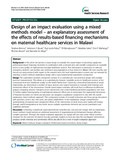Design of an impact evaluation using a mixed methods model – an explanatory assessment of the effects of results-based financing mechanisms on maternal healthcare services in Malawi
Date
2014Publisher
BMC Health Services ResearchAuthor
Brenner, StephanMuula, Adamson S
Robyn, Paul Jacob
Bärnighausen, Till
Sarker, Malabika
Mathanga, Don P
Bossert, Thomas
Allegri, Manuela De
Metadata
Show full item recordCitation
Brenner, S., Muula, A. S., Robyn, P. J., Bärnighausen, T., Sarker, M., Mathanga, D. P., … De Allegri, M. (2014). Design of an impact evaluation using a mixed methods model--an explanatory assessment of the effects of results-based financing mechanisms on maternal healthcare services in Malawi. BMC Health Services Research, 14(1), 180. http://doi.org/10.1186/1472-6963-14-180Abstract
Background: In this article we present a study design to evaluate the causal impact of providing supply-side
performance-based financing incentives in combination with a demand-side cash transfer component on equitable
access to and quality of maternal and neonatal healthcare services. This intervention is introduced to selected
emergency obstetric care facilities and catchment area populations in four districts in Malawi. We here describe and
discuss our study protocol with regard to the research aims, the local implementation context, and our rationale for
selecting a mixed methods explanatory design with a quasi-experimental quantitative component.
Design: The quantitative research component consists of a controlled pre- and post-test design with multiple
post-test measurements. This allows us to quantitatively measure ‘equitable access to healthcare services’ at the
community level and ‘healthcare quality’ at the health facility level. Guided by a theoretical framework of causal
relationships, we determined a number of input, process, and output indicators to evaluate both intended and
unintended effects of the intervention. Overall causal impact estimates will result from a difference-in-difference
analysis comparing selected indicators across intervention and control facilities/catchment populations over time.
To further explain heterogeneity of quantitatively observed effects and to understand the experiential dimensions
of financial incentives on clients and providers, we designed a qualitative component in line with the overall
explanatory mixed methods approach. This component consists of in-depth interviews and focus group discussions
with providers, service user, non-users, and policy stakeholders. In this explanatory design comprehensive
understanding of expected and unexpected effects of the intervention on both access and quality will emerge
through careful triangulation at two levels: across multiple quantitative elements and across quantitative and
qualitative elements.
Discussion: Combining a traditional quasi-experimental controlled pre- and post-test design with an explanatory
mixed methods model permits an additional assessment of organizational and behavioral changes affecting
complex processes. Through this impact evaluation approach, our design will not only create robust evidence
measures for the outcome of interest, but also generate insights on how and why the investigated interventions
produce certain intended and unintended effects and allows for a more in-depth evaluation approach.

